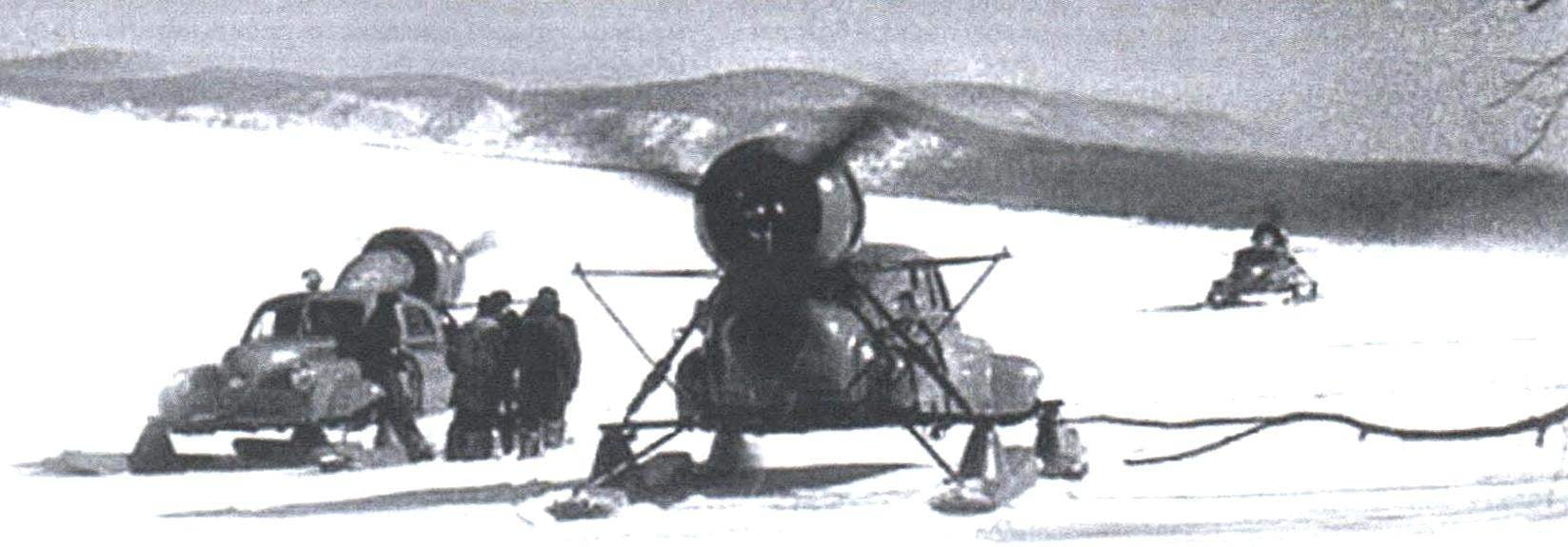ensure the safety of passengers and crew area of rotation of the propeller had tubular fence, painted in bright red color; on the outer pipe ends of the fence mounted Parking lights red and green.
Lubrication system, oil MS-20 or MK-22, consisted of oil tank installed in the pylon fairing on the roof, and oil cooler in the lower rear of the body. For blowing past outside, on the sides of the rear body, it was a two intake.
Starting the engine is performed by the driver by means of compressed air coming from the cylinder. Filling the air the last was performed by a compressor located in the engine, or from an external source. If necessary, when severe frosts, warm up the engine before start with hot air from a stationary heater.
The front suspension was different from the “Poberovskii” sizes only cross-beam – it had to extend to the front track match the back.
Operation of the snowmobile “North-2”
Mass production of the snowmobile “North-2” was deployed in the far Eastern seaside town of Arsenyev plant “Progress”, which, along with the defense products produced for the society DOSAAF gliders and training aircraft Yak-18A. The first nine production vehicles was delivered to the Komsomolsk-on-Amur on 26 November 1960 commenced postal traffic. In the process of operation of the sled it identified many deficiencies. To eliminate them in the design of cars has made a number of enhancements: in particular, strengthened the body, changed the design of the ski. However, the front suspension is borrowed from the “Victory” turned out to be too weak for heavier vehicles.
During the period from 1960 to 1961, “Progress” has released 100 snowmobile “North-2”, and most of them (97 machines) placed at the disposal of transport enterprises of the Ministry of communications, where they were used to deliver mail to areas which previously could be reached only by air or dogsled.
More than just a lucky snowmobile that is sent in the Khabarovsk territory there were organized courses of drivers of these cars, and sheds for their storage and repair. But this approach to new technology was the exception rather than the rule. Other transport departments of the Ministry of communications is sometimes not stocked even aviation gasoline and oil, not to mention the construction of shelters for snowmobiles and boxes to repair them.
Snowmobile “North-2” – exhibit of the Museum of the air forces in Monino (photo snowmobile equipped with erratic wheel chassis)
Snowmobile “North-2” in the test run
Snowmobile “North-2” on the withdrawable chassis is in the Museum of the air forces of Russia (Monino)
Annual mileage postage snowmobile “North-2” made about 13 thousand km at an average speed of 30 km/h. the Tracks were on virgin snow and hummocky ice, and go flight drivers had sometimes at temperatures up to 50 degrees below zero. Mail was delivered to the villages located on the banks of the Amur, the Ob, Lena and Pechora, carried out regular mail and passenger flights in the Far East, Kazakhstan and Siberia.
The time mercilessly not only to people but also to their creations. No exception snowmobile “North-2” – almost all of them within three to four years due to total wear was decommissioned, and they were replaced by more versatile, more durable and more capacious snowmobile Ka-30 car scheme set up in the same “helicopter” design Bureau headed by N. And. Kamov. As for the snowmobile “North-2”, from hundreds of serial machines, to the present day preserved only, not a complete copy of these snowmobiles, which is stored in Monino aviation Museum. Unfortunately, the question of its restoration is not due to lack of funding this project.
Technical characteristics of the snowmobile “North-2”
Length, mm……………………………………………………………………………….6010
Width, mm……………………………………………………………………………2925
Height, mm……………………………………………………………………………..3270
Base, mm………………………………………………………………………………….3415
Track, mm………………………………………………………………………………..2500
The diameter of the propeller, mm……………………………………………….2700
Maximum chassis weight, kg……………………………………………..2350
Engine designation……………………………………………………AI-14РС
Engine power, HP…………………………………………………………..260
Payload, kg………………………………………………………..500
Maximum speed, km/h……………………………………………………..70
The duration of the course, h……………………………………………………. 5
Range, km……………………………………………………………………360
 Limitless Russian expanses, but in winter their snowy immensity had become impassable for virtually all vehicles. That is why with the advent of powerful internal combustion engines, the designers started thinking about creating machines that are able to easily overcome this “snow-covered vastness”. The choice of propulsion device for a snowmobile vehicle, it was a small caterpillar, wheel Yes auger. In combination with the supporting pillars, mostly with skis – at the beginning of XX century was built a lot of all kinds of snowmobiles. However, such machines did not have either the terrain or speed.
Limitless Russian expanses, but in winter their snowy immensity had become impassable for virtually all vehicles. That is why with the advent of powerful internal combustion engines, the designers started thinking about creating machines that are able to easily overcome this “snow-covered vastness”. The choice of propulsion device for a snowmobile vehicle, it was a small caterpillar, wheel Yes auger. In combination with the supporting pillars, mostly with skis – at the beginning of XX century was built a lot of all kinds of snowmobiles. However, such machines did not have either the terrain or speed.